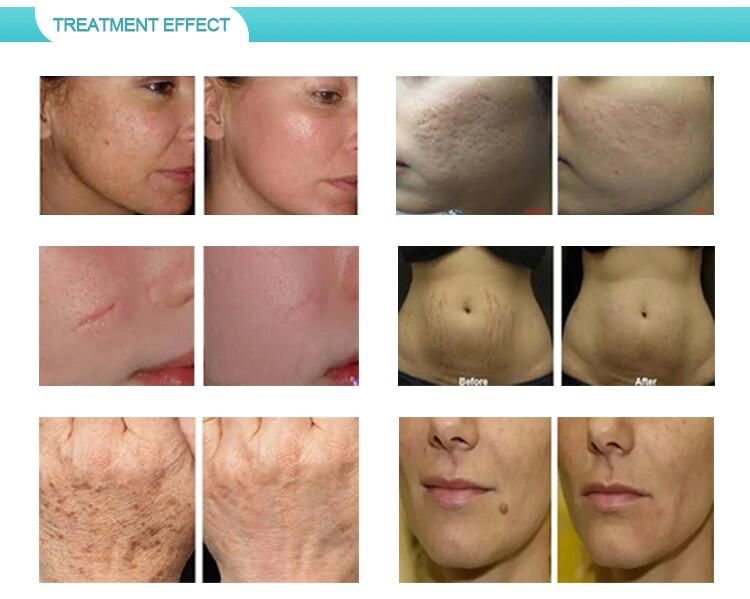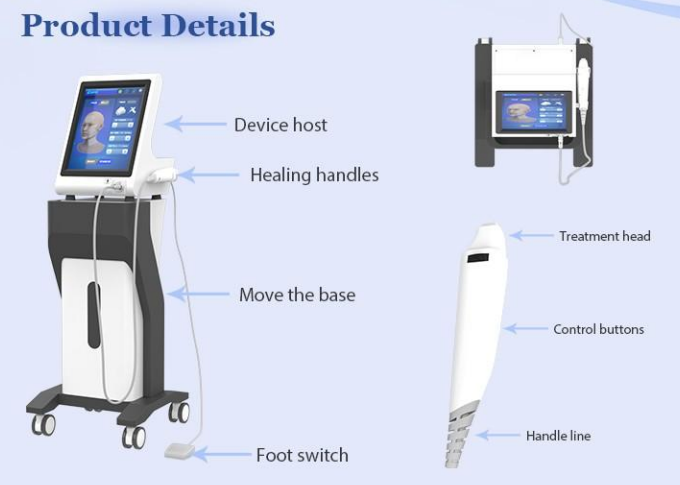What is the difference between CO2 laser and Nd:YAG?
CO2 Laser: Principles and Applications
The working wavelength of CO2 fractional laser is 10600nm, which uses the principle of selective photothermal decomposition. This laser works by creating tiny holes in the skin, which creates thermal exfoliation, coagulation, and thermal effects within the skin layers. These processes trigger a series of biochemical reactions that stimulate the skin’s natural repair mechanisms, resulting in firmer, rejuvenated skin and reduced hyperpigmentation and scarring.
The CO2 laser is particularly effective in treating deep wrinkles, severe sun damage, and visible scars. The precision of the CO2 laser allows for targeted treatment, ideal for delicate areas such as around the eyes and mouth. Additionally, the thermal effect of the CO2 laser promotes collagen production, which is essential for maintaining skin elasticity and firmness.
Nd:YAG Lasers: Mechanism and Applications
On the other hand, Nd:YAG laser operates at a wavelength of 1064nm. This laser is known for its ability to penetrate the skin more deeply than other laser types. The Nd:YAG laser works by emitting a high-intensity beam that is absorbed by the pigment in the hair follicle or skin lesion, destroying it without damaging surrounding tissue.
The Nd:YAG laser is very effective for hair removal, especially for people with darker skin tones, because the laser’s wavelength is less likely to be absorbed by the melanin in the skin. This laser is also used to treat vascular lesions such a spider veis and hemangiomas, as well as for skin tightening and rejuvenation.
Comparative Analysis: CO2 Laser vs. Nd:YAG Laser
When comparing CO2 lasers to Nd:YAG lasers, several key differences emerge. First, the CO2 laser has a wavelength of 10600nm, which allows for more superficial treatments and is ideal for resolving surface skin problems such as fine lines, wrinkles, and pigmentation. In contrast, the Nd:YAG laser’s 1064nm wavelength allows for deeper penetration, making it more suitable for treating deeper skin structures such as hair follicles and vascular lesions.
Second, the CO2 laser’s mechanism of creating tiny holes in the skin allows for more aggressive treatment and longer recovery times. Patients undergoing carbon dioxide laser treatment may experience redness, swelling, and peeling for days to weeks after treatment. In contrast, Nd:YAG laser treatment typically requires minimal downtime, and patients are usually able to return to normal activities immediately following surgery.
Effectiveness and Suitability
The effectiveness of each laser type depends largely on the specific skin problem being addressed. For individuals seeking to improve skin texture, reduce deep wrinkles, and treat severe sun damage, the CO2 laser is often the first choice due to its ability to stimulate collagen production and promote significant skin regeneration. On the other hand, for those looking to remove unwanted hair, treat vascular lesions, or achieve skin tightening with minimal downtime, the Nd:YAG laser is more suitable.
Safety and Side Effects
Both CO2 and Nd:YAG lasers are considered safe when operated by qualified professionals. However, the carbon dioxide laser is more aggressive, which means it carries a higher risk of side effects, such as prolonged redness, swelling, and potential scarring. Nd:YAG laser, while generally safer for darker skin tones, can still cause temporary side effects such as redness and swelling.
in conclusion
In summary, the choice between CO2 laser and Nd:YAG laser depends on the specific skin problem and desired results. The CO2 laser is very effective for surface rejuvenation and treating deep wrinkles, while the Nd:YAG laser excels at hair removal, treating vascular lesions and providing skin tightening with minimal downtime. Consulting with a qualified dermatologist or cosmetic professional is essential to determine which laser treatment is best for your individual needs.
Final Thoughts
As laser technology continues to advance, skin rejuvenation and treatment options are becoming more diverse. Understanding the differences between CO2 and Nd:YAG lasers can help you make an informed decision and get the best results for your skin. Whether you’re looking to reduce wrinkles, remove unwanted hair, or treat scars, there’s a laser treatment to suit your needs.





































